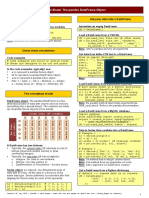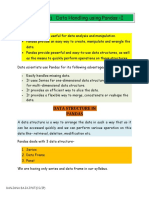0% found this document useful (0 votes)
69 views5 pagesPandas
The document discusses creating and manipulating DataFrames in Python Pandas. It covers topics like creating DataFrames from different data structures, selecting data, filtering, adding/modifying columns and rows, importing/exporting CSV files, and descriptive statistics.
Uploaded by
khushhal2024Copyright
© © All Rights Reserved
We take content rights seriously. If you suspect this is your content, claim it here.
Available Formats
Download as DOCX, PDF, TXT or read online on Scribd
0% found this document useful (0 votes)
69 views5 pagesPandas
The document discusses creating and manipulating DataFrames in Python Pandas. It covers topics like creating DataFrames from different data structures, selecting data, filtering, adding/modifying columns and rows, importing/exporting CSV files, and descriptive statistics.
Uploaded by
khushhal2024Copyright
© © All Rights Reserved
We take content rights seriously. If you suspect this is your content, claim it here.
Available Formats
Download as DOCX, PDF, TXT or read online on Scribd
/ 5






















































